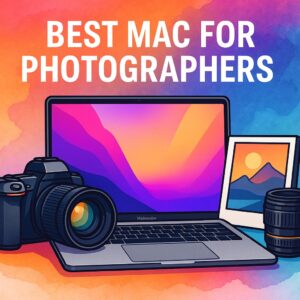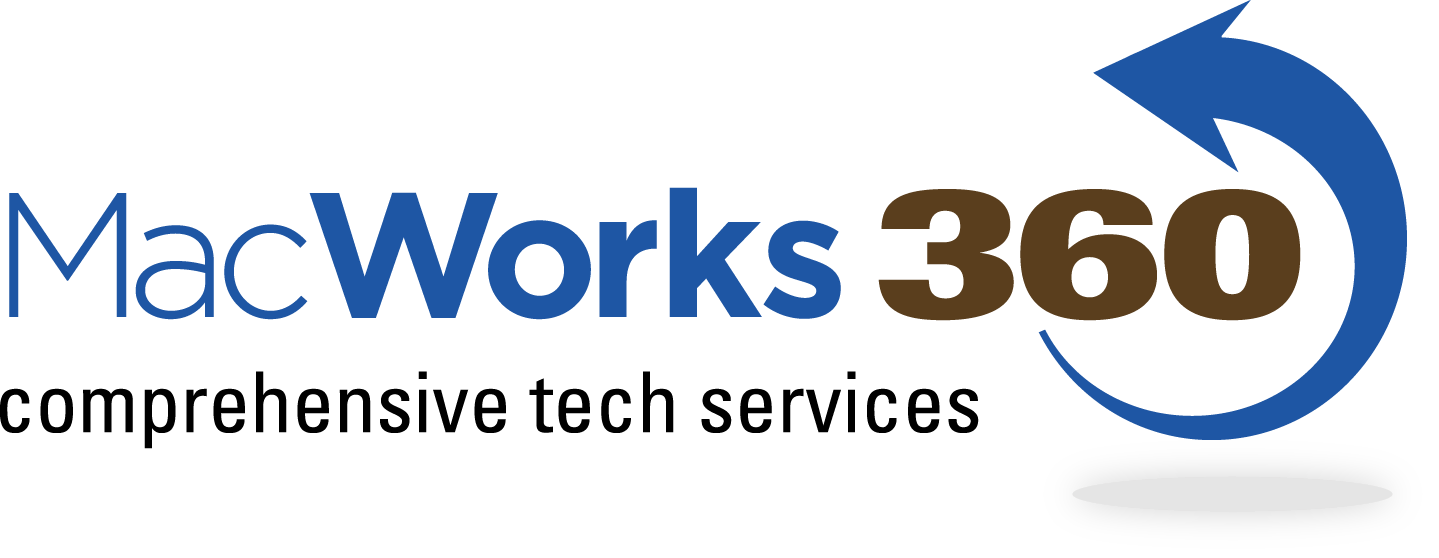Best Mac for Photographers | MacWorks 360

Best Mac for Photographers
Fun fact: the first digital camera (1975) saved a 0.01MP image to cassette tape. Today, 61MP RAW files are normal—so choose the best Mac for photographers with the right RAM, SSD, and ports for fast imports and edits.
This guide gives quick picks for Lightroom, Capture One, wedding/event, travel, and studio tethering—plus simple spec rules.
Quick Picks by Photo Workflow
- Lightroom Classic (large catalogs): MacBook Pro 14-inch (M3 Pro), 36–48 GB RAM, 1–2 TB SSD.
- Capture One + Tethered Studio: Mac Studio (M3 Max) for ports/thermals; 64 GB RAM; 2 TB SSD.
- Wedding/Event (heavy culling + exports): MacBook Pro 16-inch (M3 Max); 64 GB RAM for massive shoot days.
- Travel/Hybrid Photo+Video: MacBook Pro 14-inch (M3 Pro); add fast Thunderbolt NVMe for 4K clips.
- Budget Desktop: Mac mini (M3) + calibrated 4K/5K display; 24–32 GB RAM; 1 TB SSD.
Apps: Lightroom · Capture One · DxO PhotoLab
How to Choose the Best Mac for Photographers
- RAM rule of thumb. 36 GB for active shooters; 48–64 GB for heavy panoramas, HDR, or medium format.
- SSD rule. 1 TB internal minimum; 2–4 TB if you travel. Keep current projects on fast external NVMe (Thunderbolt).
- CPU/GPU. Photo apps are CPU-heavy, but AI denoise and upscaling benefit from more GPU cores.
- Ports & readers. SDXC on MBP is handy; for CFexpress/XQD, plan a dedicated Thunderbolt reader and hub.
- Displays. Aim for a calibrated 4K/5K display with good uniformity and wide color (P3).
- Backup. Use the 3-2-1 rule: 3 copies, 2 media types, 1 off-site (NAS or cloud).
Recommended Macs
MacBook Pro 14-inch (M3 Pro)
Portable power for travel and on-site edits. Great battery, SD slot, bright display.
- Spec: 12-core CPU / 18-core GPU or better; 36–48 GB RAM; 1–2 TB SSD.
- Use cases: Lightroom Classic, PhotoLab, Adobe Camera Raw, on-location culling.
- Learn more at Apple
MacBook Pro 16-inch (M3 Max)
Mobile workstation for huge weddings/events or heavy AI work.
- Spec: Higher-bin GPU; 64–96 GB RAM; 2 TB SSD.
- Use cases: Massive exports, noise reduction, hybrid 4K video timelines.
- Learn more at Apple
Mac Studio (M3 Max)
Quiet desktop with many ports and sustained performance—perfect for tethered studio sessions.
- Spec: 64–96 GB RAM; 2–4 TB SSD; extra GPU cores if you batch denoise a lot.
- Use cases: Capture One tethering, high-res retouching, batch processing.
- Learn more at Apple
Mac mini (M3)
Value desktop for photo editing with the right display.
- Spec: 24–32 GB RAM; 1–2 TB SSD.
- Use cases: Lightroom + Photoshop, small studios, client review stations.
- Learn more at Apple
Quick Comparison
| Workflow | Mac | RAM | Notes |
|---|---|---|---|
| Lightroom catalogs | MBP 14 (M3 Pro) | 48–64 GB | Fast SSD for previews |
| Wedding/Event | MBP 16 (M3 Max) | 64–96 GB | Crush exports, AI denoise |
| Studio tethering | Mac Studio (M3 Max) | 64–96 GB | Ports + thermals for sessions |
| Budget desktop | Mac mini (M3) | 32–64 GB | Pair with calibrated 4K/5K |
Displays, Storage, and Backup
- Displays: 27-inch 5K or quality 4K with P3 gamut; hardware calibration recommended.
- Card readers: Use Thunderbolt CFexpress/XQD for stable tethering and fast imports.
- Storage: Active projects on Thunderbolt NVMe; archives on NAS. See Synology NAS for Creative Teams.
- Backup: Time Machine + versioned NAS/cloud. Test restores quarterly.
FAQs: Best Mac for Photographers
How much RAM is enough for photography?
48 GB handles big catalogs and culling. Go 64–128 GB for panoramas, stacks, or medium format.
Is internal SSD or external faster?
The internal SSD is fastest. Use a Thunderbolt NVMe enclosure for projects to keep the internal drive roomy and fast.
Can I upgrade later?
No. RAM and internal SSD are fixed on Apple silicon. Buy what you need up front.
Need help picking the best Mac for photographers?
MacWorks 360 specifies, deploys, and supports photo workflows across New Jersey—from single shooters to studios. We handle data migration, storage, backup, and color-accurate displays.
Contact us · Managed IT for Mac · Synology NAS for Creative Teams
Based in Springfield, NJ—serving Summit, Millburn, Short Hills, Chatham, Montclair, and beyond.
Editor’s note: Recommendations reflect hardware available as of August 2025.
